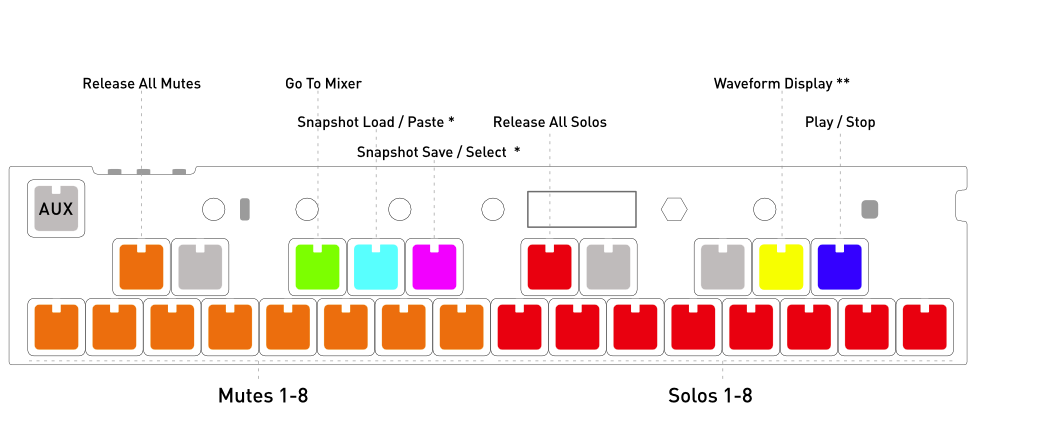-
Notifications
You must be signed in to change notification settings - Fork 38
MIDI Keyboard
AUX Shortcut keys:
- Holding AUX lets you quickly edit the selected parameter
- Bottom keys 1 and 2 are octave up/down
- Top keys 1 and 2 cycle through the selected parameter on the display
- Top key 5 disables MidiFX
- Top keys 6-10 selects a MidiFX Group to use
- Double click or long hold a MidiFX Group to enter the MidiFX submode
- Bottom key 12 enters the arpeggiator pass-through submode
- Pass-through allows you to edit the parameters of the arpeggiator while also still using the keyboard to play notes
- Bottom key 13 cycles through arpeggiator patterns
- Bottom key 14 cycles through arpeggiator octave ranges
- Bottom key 15 toggles the arpeggiator hold function
- Bottom key 16 toggles the arpeggiator on and off
Parameters:
Page 1:
-
OCT: current Octave -
CH: active MIDI Channel -
CC: displays CC being sent when turning a potentiometer -
NOTE: displays the last note number that was sent
Page 2:
-
RR: RoundRobin MIDI Channel distribution -
RROF: RR offset value -
PGM: MIDI program change -
BNK: MIDI bank select.
Page 3:
-
PBNK: Potentiometer bank select -
THRU: when "On" incoming USBMIDI is passed to TRS MIDI Out. -
MCRO: MIDI Macro Mode Select (default is OFF) -
M-CH: MIDI Macro Mode Channel
Page 4:
-
ROOT: select the root note for scale mode -
SCALE: select a scale or turn off scale mode -
LOCK: locks to the active scale. If this is enabled, you can only play notes in the scale -
GROUP: groups all the notes of the scale across the lower row of 16 keys.
Page 5:
-
CC: press the encoder to enter the CC configuration submode.
Scales can be turned on using the 4th parameter page. When a scale is enabled, the keys in the scale light up, and the root notes light up a brighter color. You can still play chromatically and out of key.
Enabling the 'LOCK' param makes it so only the notes in the scale send midi notes out.
Turning on the 'GROUP' parameter maps the scale across the lower row of 16 keys. The root note starts on bottom key 2 which would normally be a C in chromatic mode.
These scale settings also control the scale of the Scaler MidiFX when they are set to use the global scale.
This mode lets you change the CC values that the potentiometers send out.
Bottom Keys 1-5 let you quickly change the selected bank.
Press the AUX key to exit.
Midi macro modes are specialized Midi controller modes designed to be used with specific hardware that can be controlled via Midi.
If a midi macro is selected, you can double click the AUX key to enter the midi macro mode, and double click the AUX key to exit the macro mode.
Midi macro modes send control midi commands on the Midi Macro channel, which is M-CH in the parameters.
From MI Mode, be sure M8 is selected from the MCRO parameter and then double click the AUX button to enter Macro Mode.
M-CH should be set to the same value as the Control Map Channel in the M8 MIDI settings screen. Default is set to channel 10.
Double click the AUX button again to exit Macro Mode.
The M8 macro mode has two pages, which change what the Keys do.
- Mute Solo Page:
The bottom row of keys correspond to mutes (orange) and solos (red). The top "black keys" are as follows:
Orange - release all mutes
Lime - go to mixer screen
Cyan - snapshot load/paste *
Magenta - snapshot save/enter selection mode *
Red - release all solos
Yellow - waveform display
Blue - play

When M8 is selected from the MCRO parameter - potentiometers send on the M-CH MIDI channel in both regular keyboard mode and in the macro mode. However, notes played on keys send on the currently selected CH MIDI channel.
* Notes:
-
M8 must be on the Mixer view for snapshots.
-
Snapshot Load uses the M8 key combo [SHIFT]+[OPTION]. On any view with a grid (song, chain, phrase, table, etc.) this key enters selection mode.
-
Snapshot Save uses the M8 key combo [SHIFT]+[EDIT]. On any view with a grid this key pastes the copied contents from selection mode.
-
Control Page:
This page lets you navigate the M8 using the keys on the device instead of the keys on the M8.
Top Key 1 and Bottoms Keys 1-3: These correspond to the directional arrow keys.
Top Key 4: Option Key Top Key 5: Edit Key Bottom Key 6: Shift Key Bottom Key 7: Play Key
The right half of the Keyboard is a 1-octave midi keyboard that sends notes on the same midi channel as when not in macro mode.